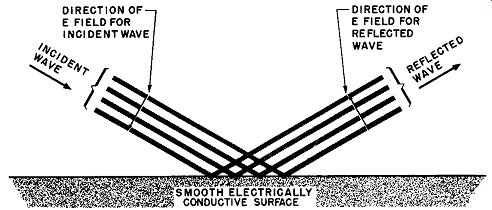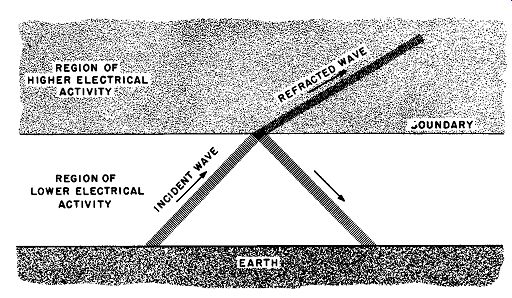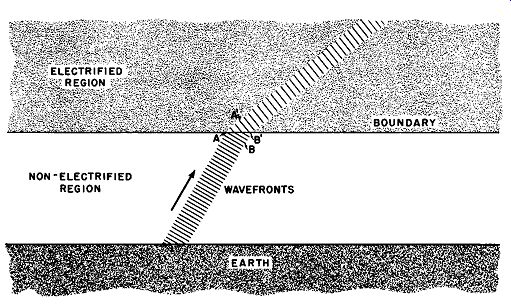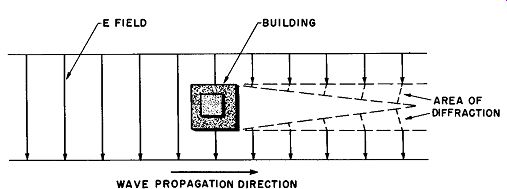AMAZON multi-meters discounts AMAZON oscilloscope discounts
7. Sky Waves
Electromagnetic waves can travel between a transmitter and a receiver in two principal ways. The first of these, known as sky wave propagation, is used primarily for long distance radio trans mission.
In sky wave propagation, as described in more detail in Sects. 3 and 5, the electromagnetic waves do not travel directly between the transmitter and receiver. Instead, these waves travel from the antenna up into the earth's atmosphere until they strike electrified regions (these regions are described in more detail in Sect. 3) , where their direction is then changed downward toward the receiving antenna.
Since the electrical characteristics of these regions change from day to day and even from hour to hour, sky wave propagation is variable. At times the sky wave is reflected downward at such an angle that it will not strike the receiving antenna, and thus no sky wave reception can occur.

Fig. 7. Wave Reflection.
8. Ground Waves
The second method by which electromagnetic waves travel from transmitter to receiver is known as ground wave propagation.
Short distance radio transmission (for example, where a radio broadcast originating in a city is received in the same city) takes place primarily by means of ground waves.
In ground wave propagation, as described in more detail in Sect. 3, the electromagnetic waves travel along the earth directly from the transmitter to the receiver. Propagation of the ground wave is determined by the electrical characteristics of the earth (note that a portion of the path can be over land and another portion over water) and by the manner in which the wave is bent or refracted because of the curvature of the earth. These electrical characteristics differ from place to place, but do not change with time. Consequently, ground wave propagation between a given transmitter and a given receiver generally remains constant.
9. Combination of Sky and Ground Waves
Occasionally, a transmitter and receiver will have to be placed in a location where reception is difficult. In a typical situation of this kind, ground wave reception by itself is not satisfactory, while the sky wave reception is too erratic.
When sky wave and ground wave transmission are used together, however, the received signal resulting from this combination can be of sufficient quality to provide adequate reception under average conditions. Unfortunately, the combination of sky waves and ground waves is often troublesome, because they get out of phase with each other and cause selective fading, as explained in Sect. 5.
10. Wave Reflection
Electromagnetic waves can be reflected from certain surfaces as light is reflected from a mirror.
Large smooth surfaces of good electrical conductivity, such as copper plate, are good reflectors for electromagnetic waves. The surface of the earth can be a good reflector, and (as will be shown in Sect. 3) the electrically conductive layers of the earth's atmosphere are also good reflectors.
Figure 7 shows an electromagnetic wave being reflected from a smooth electrically-conductive surface. As in the case of light waves, the angle of incidence is always equal to the angle of reflection. Note also the change of phase of the E field.
11. Combined Refraction and Reflection

Fig. 8. Reflection and refraction of an electromagnetic wave as It passes
the boundary between two media of different electrical density.
For reasons that will be analyzed in the next Section, different regions of the upper atmosphere are subject to electrical disturbances of various intensities. Although the velocity of an electromagnetic wave is generally considered constant in a vacuum - that is, in a medium such as "empty" space -- the presence of electrical particles in varying states of excitation produces changes in the wave's velocity. In highly electrified regions, the velocity of propagation is greater than in a space where little or no electrification exists. As the medium changes its character due to the action of the sun or of cosmic rays, boundaries between regions of differing electrification make their appearance; these are not sharply defined because, by the very nature of the causative agents, the variations in wave-carrying ability are inevitably gradual. For the purposes of this preliminary discussion, however, we shall assume a sharp separation between media of different atmospheric character and call this the boundary, as in Fig. 8.
An electromagnetic wave, rising from the earth and striking the boundary at an angle of 90 degrees, is slowed down uniformly all along its wave front. However, if the wave meets the boundary at an angle other than 90 degrees, as in Fig. 8, one portion of the wave is reflected and another portion penetrates the boundary.
As it emerges on the other side, its direction is no longer the same as that of the incident wave. This bending process is called refraction and may be explained by referring to Fig. 9 and the following text.

Fig. 9. Refraction due to change of velocity.
Consider wave front A-B. Since the speed of the wave front is greater in the electrified than in the non-electrified region, point A of the incident wave front advances over distance A-A' in the same period of time in which point B moves through the smaller distance B-B'. B-B' is a smaller distance because the velocity is lower in this region.

Fig. 10. Wave diffraction.
As a result of the inequality of the distances covered in a unit time, the wave front no longer presents the same angle to the boundary as it did in the incident wave. Hence the direction of propagation has been altered.
Refraction always occurs when an electromagnetic wave passes from one medium to another at an angle other than 90 degrees, provided that the two media have different intensities of electrification. The extent to which refraction occurs is dependent upon the ratio of velocities in the two media. This ratio is called the refractive index and may be used to compute the amount of bending that may be expected at any angle.
12. Wave Diffraction
When a light wave in an otherwise dark room shines on the edge of an opaque object, it will be found that the object will not cast a sharply outlined shadow; the shadow will be somewhat fuzzy, because the light waves are bent or diffracted around the edge of the object and decrease the area of total shadow. The dif fraction of light waves is very small.
Electromagnetic radio waves are diffracted in the same manner, but to a greater extent, as shown in Fig. 10. Thus they can be received even when there is an obstruction such as a building be tween a transmitter and a receiver.
Diffraction can be an important consideration for long distance reception, because the earth, due to its curvature, can obstruct waves travelling directly from a transmitter to a receiver. To a small degree, diffraction overcomes this obstruction. This effect is described in more detail in Sect. 4.
13. QUIZ
(1) What are the two principal ways in which waves can travel between a transmitter and a receiver.
(2) Wave propagation over short distances normally involves sky wave propagation. True or False?
(3) Is sky wave propagation more useful than ground wave propagation? Explain.
(4) Does wave refraction always occur when a wave passes from one medium into another?
(5) Define refractive index.
(6) Can radio waves be received when there is an obstruction between the transmitter and the receiver?
(7) What is the difference between refraction and diffraction?
(8) The refractive index of water determines the amount of refraction of a wave passing from air into water at an angle of 90 degrees. True or False?